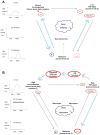Neuroimmune endocrine effects of antidepressants
- PMID: 22347798
- PMCID: PMC3280108
- DOI: 10.2147/NDT.S16409
Neuroimmune endocrine effects of antidepressants
Abstract
Antidepressant pharmacotherapy is to date the most often used treatment for depression, but the exact mechanism of action underlying its therapeutic effect is still unclear. Many theories have been put forward to account for depression, as well as antidepressant activity, but none of them is exhaustive. Neuroimmune endocrine impairment is found in depressed patients; high levels of circulating corticosteroids along with hyperactivation of the immune system, high levels of proinflammatory cytokines, low levels of melatonin in plasma and urine, and disentrainment of circadian rhythms have been demonstrated. Moreover, antidepressant treatment seems to correct or at least to interfere with these alterations. In this review, we summarize the complex neuroimmune endocrine and chronobiological alterations found in patients with depression and how these systems interact with each other. We also explain how antidepressant therapy can modify these systems, along with some possible mechanisms of action shown in animal and human models.
Keywords: antidepressant agents; biological markers; cytokines; endophenotype; human; neuroinflammation; psychoneuroimmunology.
Figures




Similar articles
-
Alcohol, antidepressants, and circadian rhythms. Human and animal models.Alcohol Res Health. 2001;25(2):126-35. Alcohol Res Health. 2001. PMID: 11584551 Free PMC article. Review.
-
Associations between Melatonin, Neuroinflammation, and Brain Alterations in Depression.Int J Mol Sci. 2021 Dec 28;23(1):305. doi: 10.3390/ijms23010305. Int J Mol Sci. 2021. PMID: 35008730 Free PMC article. Review.
-
Dysregulation of neuroendocrine crossroads: depression, circadian rhythms and the retina--a hypothesis.Prog Neuropsychopharmacol Biol Psychiatry. 1987;11(2-3):267-78. doi: 10.1016/0278-5846(87)90070-4. Prog Neuropsychopharmacol Biol Psychiatry. 1987. PMID: 2888161
-
Antidepressants with different mechanisms of action show different chronopharmacological profiles in the tail suspension test in mice.Chronobiol Int. 2019 Sep;36(9):1194-1207. doi: 10.1080/07420528.2019.1625360. Epub 2019 Jun 14. Chronobiol Int. 2019. PMID: 31198056
-
[The role of immune system in depression].Psychiatriki. 2010 Jan;21(1):17-30. Psychiatriki. 2010. PMID: 22214869 Greek, Modern.
Cited by
-
Involvement of indoleamine 2, 3-dioxygenase (IDO) and brain-derived neurotrophic factor (BDNF) in the neuroprotective mechanisms of ferulic acid against depressive-like behaviour.Metab Brain Dis. 2023 Oct;38(7):2243-2254. doi: 10.1007/s11011-023-01267-7. Epub 2023 Jul 25. Metab Brain Dis. 2023. PMID: 37490224 Free PMC article.
-
A Randomized, Double-blind, Placebo-controlled Trial of Celecoxib Augmentation of Sertraline in Treatment of Drug-naive Depressed Women: A Pilot Study.Iran J Pharm Res. 2015 Summer;14(3):891-9. Iran J Pharm Res. 2015. PMID: 26330878 Free PMC article.
-
Understanding Sleep-Wake Behavior in Late Chronotype Adolescents: The Role of Circadian Phase, Sleep Timing, and Sleep Propensity.Front Psychiatry. 2022 Mar 11;13:785079. doi: 10.3389/fpsyt.2022.785079. eCollection 2022. Front Psychiatry. 2022. PMID: 35360141 Free PMC article.
-
Immune-pineal axis: nuclear factor κB (NF-kB) mediates the shift in the melatonin source from pinealocytes to immune competent cells.Int J Mol Sci. 2013 May 24;14(6):10979-97. doi: 10.3390/ijms140610979. Int J Mol Sci. 2013. PMID: 23708099 Free PMC article. Review.
-
Possible link between Toxoplasma gondii and the anosmia associated with neurodegenerative diseases.Am J Alzheimers Dis Other Demen. 2014 May;29(3):205-14. doi: 10.1177/1533317513517049. Epub 2014 Jan 10. Am J Alzheimers Dis Other Demen. 2014. PMID: 24413543 Free PMC article. Review.
References
-
- Kessler RC. Epidemiology of women and depression. J Affect Disord. 2003;74(1):5–13. - PubMed
-
- O’Brien SM, Scott LV, Dinan TG. Cytokines: abnormalities in major depression and implications for pharmacological treatment. Hum Psychopharmacol. 2004;19(6):397–403. - PubMed
-
- Carvalho LA, Pariante CM. In vitro modulation of the glucocorticoid receptor by antidepressants. Stress. 2008;11(6):411–424. - PubMed
LinkOut - more resources
Full Text Sources

